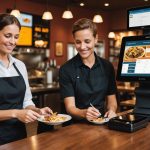Selecting the right POS system can significantly impact the efficiency of a restaurant, especially one offering both dine-in and drive-through services. An ideal POS must streamline orders, enhance customer experience, and provide essential data insights. By focusing on user-friendly interfaces, robust inventory management, and comprehensive reporting, restaurants can optimize their operations and improve service quality. Explore the key features necessary for a POS system that not only meets the demands of a fast-paced environment but also elevates the overall dining experience for customers.
Essential Features of POS Systems for Restaurants
Understanding the essential features of a POS system is crucial for any restaurant aiming to streamline operations. These systems must cater to both dine-in and drive-through solutions, ensuring efficiency and seamless service.
Also read : Essential Factors for Creating an Inclusive Wheelchair-Friendly Bar Space
Key functionalities of a POS system include inventory management, sales tracking, and customer relationship management. These features are vital for maintaining a smooth workflow and enhancing customer satisfaction. For restaurants operating dual service models, tailored features such as split billing and order customization are indispensable. They help in managing the unique demands of both dine-in and drive-through services.
User experience plays a pivotal role in the selection of a POS system. An intuitive interface can significantly reduce training time and minimize errors during service. As one restaurant manager noted, "A user-friendly POS system is like having an extra set of hands during the rush hour."
Also to read : Essential Dishwasher Features for Water Conservation in High-Volume Restaurants
Key Functionalities
- Inventory Management: Tracks stock levels and alerts for reordering.
- Sales Tracking: Provides detailed reports on sales trends and performance.
- Customer Relationship Management: Enhances guest experience through personalized service.
The right POS system not only enhances operational efficiency but also contributes to a positive dining experience. By focusing on these essential features, restaurants can better serve their customers and optimize their business operations.
Order Management Capabilities
Understanding the intricacies of order management is essential for enhancing restaurant efficiency and improving the customer experience. A well-designed POS system streamlines order processing for both dine-in and drive-through services, ensuring that every customer receives prompt and accurate service.
Streamlining Order Processing
Efficient order management begins with the seamless integration of dine-in and drive-through orders. This capability reduces wait times and minimizes errors, which are critical for maintaining high levels of customer satisfaction. A POS system with robust order management features allows staff to handle complex orders effortlessly, ensuring that each dish is prepared to perfection.
Customization Options
Today's diners often seek personalized experiences. The ability to customize menu items and modifications is a crucial feature of a modern POS system. This flexibility not only enhances the dining experience but also supports the restaurant's ability to cater to diverse dietary needs and preferences.
Integration with Kitchen Display Systems
Real-time updates are vital in maintaining kitchen efficiency. By integrating with kitchen display systems, a POS system ensures that orders are communicated swiftly and accurately to the culinary team. This integration facilitates a smooth workflow, reducing the likelihood of errors and ensuring timely service.
"A well-integrated POS system is the backbone of restaurant efficiency," says one industry expert.
Payment Processing Features
In the fast-paced environment of restaurants, efficient payment processing is vital for ensuring customer satisfaction. Offering multiple payment options not only caters to diverse customer preferences but also speeds up the transaction process.
Security measures are paramount in payment processing to protect sensitive customer data. Advanced encryption and tokenization techniques are employed to safeguard transactions, building trust and confidence among patrons. As one industry expert states, "Secure transactions are the cornerstone of customer loyalty."
Fast transactions significantly impact the overall customer experience. A streamlined payment processing system reduces wait times, allowing customers to enjoy a seamless dining experience. The ability to handle various payment types, including credit cards, mobile payments, and contactless options, enhances convenience and efficiency.
Key Features of Payment Processing
- Multiple Payment Options: Credit, debit, mobile, and contactless payments.
- Security Measures: Encryption, tokenization, and fraud detection.
- Impact on Customer Experience: Reduced wait times and enhanced convenience.
Implementing robust payment processing features ensures restaurants can handle peak hours with ease, maintaining high levels of customer satisfaction. By prioritizing secure and efficient transactions, restaurants not only protect their patrons but also enhance their overall dining experience.
Inventory Tracking and Management
Efficient inventory management is pivotal for restaurants aiming to optimize both costs and operations. Real-time inventory tracking enables restaurants to maintain up-to-date stock levels, crucial for both dine-in and drive-through service models.
Real-Time Inventory Tracking
Real-time tracking ensures that stock levels are constantly monitored, reducing the risk of overstocking or shortages. This feature is essential for maintaining the delicate balance between supply and demand. By integrating inventory management systems with point-of-sale technology, restaurants can streamline stock control and improve overall efficiency.
Integration with Suppliers
Seamless integration with suppliers allows for automated reordering, which is a game-changer in inventory management. This feature minimizes manual errors and ensures that ingredients are always available when needed. It also supports waste reduction by aligning orders with actual consumption patterns, thus optimizing stock control.
Benefits of Inventory Analytics
Inventory analytics provide valuable insights into consumption trends, helping restaurants make informed decisions. By analyzing data, managers can identify patterns and adjust procurement strategies accordingly. This not only aids in cost management but also enhances the overall efficiency of the restaurant.
"Effective inventory management is the backbone of a profitable restaurant," notes a seasoned restaurant consultant.
User-Friendly Interfaces
In the fast-paced restaurant environment, a user-friendly interface is essential for maximizing staff efficiency. An intuitive design minimizes training time and reduces errors, allowing staff to focus on delivering excellent service. A well-designed POS usability system should cater to the varying needs of different roles within the restaurant, from servers to managers.
Importance of Intuitive Design
An intuitive design is critical for ensuring that staff can operate the POS system with minimal effort. This ease of use translates to quicker service and happier customers. As one restaurant manager put it, "A smooth interface is like a well-oiled machine—everything just works."
Customizable Dashboards
Customizable dashboards are a significant feature, allowing different roles to access the information they need quickly. For instance, servers can focus on order entry, while managers can monitor sales performance. This customization enhances POS usability by tailoring the interface to specific job functions.
Training and Support Resources
Effective staff training is crucial for the successful implementation of any POS system. Comprehensive training resources and ongoing support ensure that all team members are comfortable with the system. This reduces the potential for errors and increases overall efficiency.
- Intuitive Design: Simplifies operations
- Customizable Dashboards: Role-specific interfaces
- Training Resources: Essential for staff onboarding
By focusing on these aspects, restaurants can enhance their operational efficiency and ensure a seamless dining experience.
Reporting and Analytics Tools
Leveraging data for strategic advantage in restaurant operations.
Key Performance Indicators
Understanding and monitoring Key Performance Indicators (KPIs) is crucial for restaurant success. KPIs provide a snapshot of operational efficiency, customer satisfaction, and financial health. Common KPIs include table turnover rates, average order value, and customer retention metrics. By focusing on these indicators, managers can pinpoint areas for improvement and make informed decisions.
Utilizing Data for Decision-Making
Data-driven decision-making is transforming how restaurants operate. By analyzing performance metrics, managers gain valuable insights into customer preferences and operational bottlenecks. This information allows for strategic adjustments, such as menu redesigns or staff reallocations, to enhance service quality and profitability. As one industry expert noted, "Data is the new oil for restaurants—it fuels growth and innovation."
Custom Report Generation
Custom report generation is a powerful tool for addressing specific business needs. Tailored reports enable managers to focus on particular aspects of their operations, such as sales trends or inventory usage. This customization ensures that the insights gathered are relevant and actionable.
- Performance Metrics: Track operational efficiency
- Business Insights: Identify growth opportunities
- Custom Reports: Tailor data to specific needs
By integrating robust reporting tools, restaurants can harness the power of data to drive success and maintain a competitive edge.
Integration with Delivery and Third-Party Services
Seamless integration with delivery platforms is transforming the restaurant industry. By aligning POS systems with third-party services, restaurants can enhance their operational efficiency and expand their customer reach. This integration allows for real-time order updates, reducing errors and improving customer satisfaction.
Consider the case of a popular pizzeria that integrated its POS system with multiple delivery services. This strategic move not only increased their order volume but also streamlined their order processing. Customers could track their orders in real-time, improving their overall experience.
Benefits of Delivery Integration
- Enhanced Efficiency: Streamlines order processing
- Customer Reach: Expands market presence
- Real-Time Updates: Reduces order errors
The future of delivery service partnerships looks promising, with advancements in technology paving the way for even more sophisticated integrations. Restaurants are exploring partnerships that offer predictive analytics to anticipate customer demands and optimize delivery routes. This not only boosts efficiency but also enhances the dining experience.
"Integration with delivery services is no longer optional; it's essential for survival in today's competitive market," says a restaurant industry expert.
As restaurants continue to evolve, embracing these third-party services becomes crucial for staying ahead in a rapidly changing landscape. This strategic approach ensures that restaurants can meet the growing demands of modern diners effectively.











